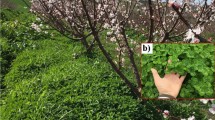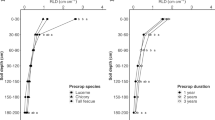Abstract
Aims
To examine the legacy of pasture drill rows sown to various configurations of subterranean clover (Trifolium subterraneum L.), lucerne (Medicago sativa L.) and phalaris (Phalaris aquatica L.), on soil chemical characteristics and wheat (Triticum aestivum L.) production in the year following pasture removal.
Methods
A field experiment comparing 10 pasture species combination treatments conducted on a Red Kandosol soil in a semi-arid environment in south-eastern Australia was monitored from the end of the pasture phase until harvest of the first wheat crop. Quadrats were fixed to the soil surface to mark previous pasture drill rows. Soil within and between rows was sampled to 0.6 m at three times and analysed for mineral nitrogen (N), pH, total carbon (C) and available macro-nutrients, and related to wheat growth rate and yield.
Results
Significantly higher total C, mineral N and plant-available potassium (K), and lower sulphur (S) concentrations, were still evident in the original pasture drill row after grain harvest compared to the inter-row area, four years after pastures were sown. Grain yield was 11% greater in wheat growing on the original pasture drill row compared to between rows. Pure lucerne swards had less mineralised N than mixed lucerne swards associated with reduced water in the soil profile.
Conclusions
This study establishes the enduring legacy of pasture drill rows observed up to 14 months post-removal and highlights the opportunity to improve soil fertility through manipulation of pasture sowing configurations in a cropping field in south-eastern Australia.








Similar content being viewed by others
Notes
Conversions to pH in CaCl2 can be made with the following equation:
pHCaCl2 = −0.1463 x (pHKCl)2 + (2.6982 x pHKCl) – 4.2403. (R2 = 0.98; n = 286; Wagga Wagga Agricultural Institute soils laboratory, G.J. Poile unpub.).
References
Alam SM (1999) Nutrient uptake by plants under stress conditions. In ‘handbook of plant and crop stress’ (Ed M Pessarakli). Pp 285–313 (Marcel Dekker: New York)
Angus JF, Gault RR, Peoples MB, Stapper M, van Herwaarden AF (2001) Soil water extraction by dryland crops, annual pastures, and lucerne in South-Eastern Australia. Australian Journal of Agricultural Research 52:183–192. https://doi.org/10.1071/AR00103
Blair G, Chinoim N, Lefroy R, Anderson G, Crocker G (1991) A soil sulfur test for pastures and crops. Soil Research 29(5):619–626
Bolger TP, Angus JF, Peoples MB (2003) Comparison of nitrogen mineralisation patterns from root residues of Trifolium subterraneum and Medicago sativa. Biol Fertil Soils 38:296–300
Boschma SP, Lodge GM, Harden S (2010) Seedling competition of lucerne in mixtures with temperate and tropical pasture species. Crop and Pasture Science 61:411–419. https://doi.org/10.1071/CP09349
Butler TJ, Stein JD, Interrante SM, Malinowski DP (2011) Novel approaches to establishing alfalfa-tall fescue pastures in the southern Great Plains. Forage and Grazinglands 9. https://doi.org/10.1094/FG-2011-0725-1001-RS
Colwell JD (1963) The estimation of the phosphorus fertilizer requirements of wheat in southern New South Wales by soil analysis. Australian Journal Experimental Agriculture and Animal Husbandry 3:190–198
Conyers MK, Davey BG (1990) The variability of pH in acid soils of the southern highlands of New South Wales Soil. Science 150:695–704
Conyers M, Orchard B, Orgill S, Oates A, Poile G, Hayes R, Hawkins P, Xu B, Jia Y, van der Rijt V, Li G (2018) Spatial variation in soil organic carbon and nitrogen at two field sites under crop and pasture rotations in southern New South Wales, Australia. Soil Res 56(8):780–792
Conyers MK, Uren NC, Helyar KR, Poile GJ, Cullis BR (1997) Temporal variation in soil acidity. Australian Journal of Soil Research 35:1115–1130. https://doi.org/10.1071/S97022
Dear BS, Ewing MA (2008) The search for new pasture plants to achieve more sustainable production systems in southern Australia. Aust J Exp Agric 48:387–396
Dear BS, Peoples MB, Cocks PS, Swan AD, Smith AB (1999) Nitrogen fixation by subterranean clover (Trifolium subterraneum L.) growing in pure culture and in mixtures with varying densities of lucerne (Medicago sativa L.) or phalaris (Phalaris aquatica L.). Aust J Agric Res 50:1047–1058. https://doi.org/10.1071/AR98186
Dear BS, Sandral GA, Virgona JM, Swan AD (2004) Yield and grain protein of wheat following phased perennial grass, lucerne, and annual pastures. Aust J Agric Res 55:775–785. https://doi.org/10.1071/AR04018
Dear BS, Virgona JM, Sandral GA, Swan AD, Morris S (2009) Changes in soil mineral nitrogen, nitrogen leached, and surface pH under annual and perennial pasture species. Crop Pasture Sci 60:975-986. https://doi.org/10.1071/CP09026
Gourley CJP, Weaver DM, Simpson RJ, Aarons SR, Hannah MM, Peverill KI (2019) The development and application of functions describing pasture yield responses to phosphorus, potassium and sulfur in Australia using meta-data analysis and derived soil-test calibration relationships. Crop Pasture Sci 70(12):1065–1079
Hayes RC, Conyers MK, Li GD, Poile GJ, Price A, McVittie BJ, Gardner MJ, Sandral GA, McCormick JI (2012) Spatial and temporal variation in soil Mn2+ concentrations and the impact of manganese toxicity on lucerne and subterranean clover seedlings. Crop and Pasture Science 63:875–885. https://doi.org/10.1071/CP12138
Hayes RC, Li GD, Gupta VVSR, Hutchings TR, Sandral GA, Swan AD, Peoples MB, Nordblom TL, Llewellyn RS (2017a) Prospects for improving the performance of mixed pasture swards by spatially separating components in drill rows. Paper presented at the in: doing more with less. Proceedings of the 18th Australian Society of Agronomy Conference, 24-28 September, Ballarat, VIC, Australia
Hayes RC, McCormick JI, Oates AA, Poile GJ, Conyers MK, Gardner MJ, Price A, O'Keeffe P, Li GD (2017b) Addressing biophysical constraints for Australian farmers applying low rates of composted dairy waste to soil. Renew Agric Food Syst 33(2):179–193
Hayes RC, Li GD, Norton MR, Culvenor RA (2018) Effects of contrasting seasonal growth patterns on composition and persistence of mixed grass-legume pastures over 5 years in a semi-arid Australian cropping environment. J Agron Crop Sci 204:228–242. https://doi.org/10.1111/jac.12258
Hayes RC, Li GD, Sandral GA, Swan AD, Price A, Hildebrand S, Goward L, Fuller C, Peoples MB (2017c) Enhancing composition and persistence of mixed pasture swards in southern New South Wales through alternative spatial configurations and improved legume performance. Crop and Pasture Science 68:1112–1130. https://doi.org/10.1071/CP16395
Hayes RC, Newell MT, Crews TE, Peoples MB (2016) Perennial cereal crops: An initial evaluation of wheat derivatives grown in mixtures with a regenerating legume. Renewable Agriculture and Food Systems 32:276–290. https://doi.org/10.1017/S1742170516000260
Hayes RC, Vadakattu VSR, Li GD, Peoples MB, Rawnsley RP, Pembleton KG (2020) Contrasting soil microbial abundance and diversity on and between pasture drill rows in the third growing season after sowing renewable agriculture and food systems 1-10. https://doi.org/10.1017/S1742170520000174
Helyar KR (1976) Nitrogen cycling and soil acidification The Journal of the Australian Institute of Agricultural Science:217–221
Hunt JR, Swan AD, Fettell NA, Breust PD, Menz ID, Peoples MB, Kirkegaard JA (2016) Sheep grazing on crop residues do not reduce crop yields in no-till, controlled traffic farming systems in an equi-seasonal rainfall environment. Field Crop Res 196:22–32
Leco (1995) Instrumentation for characterisation of organic/inorganic materials and microstructural analysis. Instruction Manual FP-2000 Protein/Nitrogen Analyses, Form No. 200–558, May 1995. (Leco Corporation: St Joseph, MI)
Li GD, Conyers MK, Schwenke GD, Hayes RC, Liu DL, Lowrie AJ, Poile GJ, Oates AA, Lowrie RJ (2016) Tillage does not increase nitrous oxide emissions under dryland canola (Brassica napus L.) in a semiarid environment of South-Eastern Australia. Soil Res 54(5):512–522
McLay CDA, Barton L, Tang C (1997) Acidification potential of ten grain legume species grown in nutrient solution. Australian Journal of Agricultural Research 48:1025–1032. https://doi.org/10.1071/A96174
Paul KI, Black AS, Conyers MK (2001) Effect of plant residue return on the development of surface soil pH gradients. Biology and Fertility of Soils 33:75–82. https://doi.org/10.1007/s003740000293
Peoples MB, Brockwell J, Hunt JR, Swan AD, Watson L, Hayes RC, Li GD, Hackney B, Nuttall JG, Davies SL, Fillery IRP (2012) Factors affecting the potential contributions of N2 fixation by legumes in Australian pasture systems. Crop Pasture Sci 63:759–786. https://doi.org/10.1071/CP12123
Rayment GE, Lyons DJ (2011) Soil chemical methods – Australasia. CSIRO Publishing, Melbourne
Sandral GA, Dear BS, Virgona JM, Swan AD, Orchard BA (2006) Changes in soil water content under annual- and perennial-based pasture systems in the wheatbelt of southern New South Wales. Australian Journal of Agricultural Research 57:321–333. https://doi.org/10.1071/AR04017
Slattery WJ, Ridley AM, Windsor SM (1991) Ash alkalinity of animal and plant products. Australian Journal of Experimental Agriculture 31:321–324. https://doi.org/10.1071/EA9910321
Smith CJ, Hunt JR, Wang E, Macdonald BCT, Xing H, Denmead OT, Zeglin S, Zhao Z (2019) Using fertiliser to maintain soil inorganic nitrogen can increase dryland wheat yield with little environmental cost. Agric Ecosyst Environ 286:106644
Tang C, Barton L, Raphael C (1998) Pasture legume species differ in their capacity to acidify soil. Australian Journal of Agricultural Research 49:53–58. https://doi.org/10.1071/A97080
Wichern F, Eberhardt E, Mayer J, Joergensen RG, Müller T (2008) Nitrogen rhizodeposition in agricultural crops: methods, estimates and future prospects. Soil Biol Biochem 40:30–48. https://doi.org/10.1016/j.soilbio.2007.08.010
Wolfe EC, Southwood OR (1980) Plant productivity and persistence in mixed pastures containing lucerne at a range of densities with subterranean clover or phalaris. Australian Journal of Experimental Agriculture and Animal Husbandry 20:189–196. https://doi.org/10.1071/EA9800189
Zadocks JC, Chang TT, Konzak CF (1974) A decimal code for the growth stages of cereals. Weed Research 14:415–421. https://doi.org/10.1111/j.13653180.1974.tb01084.x
Acknowledgements
The New South Wales Department of Primary Industries (NSW DPI) and the Grains Research and Development Corporation (GRDC) all contributed the necessary financial support for this research through the EverCrop project (CSA 00044). The technical support provided by NSW DPI staff, particularly Andrew Price, Richard Lowrie, Adam Lowrie, Binbin Xu and Peter Tyndall is gratefully acknowledged.
Author information
Authors and Affiliations
Corresponding author
Additional information
Publisher’s note
Springer Nature remains neutral with regard to jurisdictional claims in published maps and institutional affiliations.
Rights and permissions
About this article
Cite this article
Hayes, R.C., Li, G.D., Rawnsley, R.P. et al. The legacy of pasture drill rows on soil chemical characteristics and subsequent wheat production. Plant Soil 455, 319–337 (2020). https://doi.org/10.1007/s11104-020-04689-9
Received:
Accepted:
Published:
Issue Date:
DOI: https://doi.org/10.1007/s11104-020-04689-9




